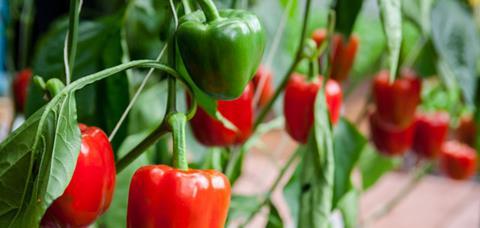
The phrase ‘size matters’ can be readily applied to the fresh produce sector, with retailers placing strict specifications on the size and shape of growers’ fruit and veg. And with that in mind, it is problematic that there has been a distinct lack of large peppers coming out of Almería so far this season.
With winter production in the Spanish region now in full swing, California bell peppers are smaller than usual, with growers reporting an 80-20 split between M or G and GG sizes. Normally, the ratio between these sizes would be roughly 50:50 by this stage in the season, but since the current season began a month late, with main production only getting under way in the second half of October, plants have had less time to mature.
For growers focused on supplying peppers for flowpacks, the smaller size of product has been less problematic. Rafael Roldán of Almería grower Ejidomar says the company has seen “no major problems” – but for others with contracts to supply a greater proportion of loose product, the lack of GG-sized peppers is proving an issue.
At Almería’s auctions, the late start to the season brought high prices because Dutch production finished earlier than in previous years, and there was little overlap between the two campaigns. At the start of the season red and yellow peppers were selling for over €1 per kg, with green priced just below the €1 mark.
As the season has progressed, and volumes have increased, prices have dropped to around €0.80 for reds and yellows, and roughly €0.60 for greens. And because the smaller sizes are in greater supply, many growers’ returns have been limited – it is the larger loose product that tends to command higher returns.
In western Europe more generally, there has been downward pressure on prices following slight oversupply in the summer. “The flushy character of the pepper crop does not help in maintaining a constant price setting,” explains Pleun van Malkenhorst of Rainbow Growers. One way of boosting returns is to expand production of speciality varieties – a trend observed by van Malkenhorst, based at Thanet Earth in Kent. “Sweet pointed and sweet baby peppers are continuing to perform well,” he says, “and Padrón peppers seem to be gaining market share too.”
With California peppers becoming commoditised, and adopted as an everyday staple in the retail price war, van Malkenhorst sees the biggest growth potential in the speciality category. “They are very good products, they’re very sweet and they have different features that blocky peppers lack,” he says. Van Malkenhorst complains that in the Netherlands most of the varietal innovation in bell peppers continues to be on delivering “bigger pieces and more yield”. “I believe it should be focused on taste and appearance,” he says.
One interesting varietal development in Spain has been the trial of purple Sweet Bite by Ejidomar, with the producer organising in-store samples at supermarkets in the UK, Germany, Sweden, Denmark and Lithuania, as well as other countries in eastern Europe. But as the company looks to develop production of more niche varieties, Roldán says it must be careful to plant sensible volumes. “If you grow too much of a premium product, it will lose its value and growers won’t want to plant it the next year,” he says.
Another relatively recent development in the category has been the removal of green bell peppers from ‘traffic light’ packs at some retailers, replaced by additional red or orange product. This change has been driven by consumer demand, according to Lee Stiles of Lea Valley Growers.
But with the Spanish season somewhat behind schedule, retailers may not have the luxury of being too picky with their peppers this season – at least for the time being.



